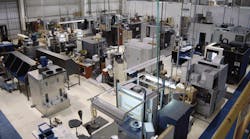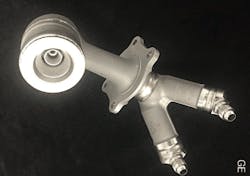In 2005, an engineer poring over designs for a new jet engine component at GE Aviation stumbled upon a sort of crazy idea: We can just make it ourselves.
She had been working with a local 3-D printing service in Cincinnati, Ohio, called Morris Technologies for about five years at that point, developing prototypes for a new kind of fuel injector.
Over that time, she had watched the additive technologies at Morris blossom from rough plastic models to finished metal pieces that almost seemed to rival the real thing. In fact, she thought, they did rival the real thing.
What’s more, she realized that “GE could use additive technologies to create intellectual property that it would not be able to do making it from traditional means,” recalls Greg Morris, cofounder and CEO of Morris Technologies.
“In fact, they could actually enhance the design by doing things they couldn’t do any other way outside of additive.”
So, the engineer thought, by abandoning the normal supply chain and its vast, global network of manufacturers responsible for producing the 20 or so components of the old fuel nozzle, GE could make a better, simple nozzle all by itself, designed and manufactured in-house.
It’s an idea that has inevitably dawned on just about every manufacturer, entrepreneur and futurist daydreamer involved in 3-D printing’s slow 30-year maturation.
In the 3-D printed supply chain, the theory goes, everything is an in-house job—every company is totally vertical and totally independent, every production effort totally local.
So as additive manufacturing builds up, the supply chain is flattened out, mashing the global web in a straight line stretching directly from producer to consumer.
It is supposed to herald a new age of innovation, of entrepreneurship, of streamlined, low-cost, high-efficiency, customizable green manufacturing.
And that sounds great. But it’s all just science fiction nonsense.
Except that GE is really doing it.
Reshaping an Industry
In 2016, GE Aviation’s additive production facility will begin printing fuel nozzles for the new LEAP jet engine—an engine that will be used to fly Airbus A320s, Boeing 737s and Comac 919s.
These are 100% 3-D printed components, designed by GE engineers and printed on GE equipment in GE factories, which will be churning out 30,000 to 40,000 of them per year by 2020.
This is exactly what the 3-D printing world has been waiting for.
“This is a fuel nozzle, not some trivial part,” Morris explains. “This is a technically exceedingly challenging part with a very, very demanding application with a critical role in the engine. It’s something that GE has never produced internally before, which it never could produce internally before. But now it will.”
And that, he says, is a big deal.
“This project alone has the promise to change the whole industry,” he says. “It’s a paradigm shift in how we design and manufacture certain components for our industrial products. It’s overwhelming how many different directions and ways GE can leverage this technology.”
Perhaps no one knows the extent of this impact better than Terry Wohlers, president and principal consultant at Wohlers Associates.
“This is an exciting time for the industry,” he says. “Additive manufacturing at this scale presents the opportunity to flatten the supply chain. Imagine consolidating 15 to 20 parts into one. Part numbers and assembly lines, certification paperwork and inspection, all of those things disappear.”
The impact of it has been developing for years, he says. Final part production, for example, has been on a steep vertical climb for over a decade, popping up in industries ranging from aerospace and medical devices to jewelry and dental crowns.
According to the Wohlers Report 2013, production of end-use parts like the fuel injector accounted for about 28.3% of the total $2.2 billion 3-D printing industry in 2012—that’s up 18% from the year previous and 626% from a decade ago.
“Final part production,” he says, “is really reshaping the entire industry.”
Building a New Supply Chain
While the industry may be reshaping, GE Aviation—like any other major corporation moving into additive—isn’t exactly in the position to reshape its own internal structure to fit. Nor was it able to develop the skills and expertise it needed to make it work overnight.
So it had to do the next best thing: It bought the experts and reshaped them.
What resulted was a comprehensive three-part manufacturing system that marks the birth of the first real 3-D printed supply chain in the major industrial world.
It began in November 2012 with the acquisition of Morris Technologies, which has since been rebranded as GE Aviation’s Additive Development Center, or ADC.
No longer a print shop, the ADC is now devoted solely to the development of new technologies, techniques and designs that will advance GE’s additive work.
“Our mission is to really innovate on the R&D side,” explains Morris, who is now the strategy/business development lead for the ADC. “We see what new things we can come up with on this technology that will help us make better parts, more robust parts, more accurate parts and better finished parts.”
Once his team has done that, he says, the CAD files for the parts are zipped across town to Morris’ biggest competitor, Rapid Quality Manufacturing. But there’s a GE Aviation sign outside that facility too now, along with a new name: the GE Additive Lean Lab (ALL).
“Their mission in life is basically to take the parts that we design and see how we can most cost-effectively produce them,” Morris explains. “They figure out how we can scale this up and make it in the most efficient process possible.”
The third stage in this process, after the ADC figures out how to make a part with the quality it needs and the ALL figures out how to make it at the price it needs, the files and the recipe will be sent over to GE’s sprawling new additive production facility for printing and shipping.
Except, there is no such facility yet. And GE has slim pickings—if any—if it hopes to acquire one with the capability and scale it needs.
And that’s a problem.
First-Mover Disadvantage
“The fact is, there doesn’t today exist a supply chain for production components,” Morris says. “There is no company I can go to around the world to produce even 10,000 fuel nozzles at the price we need. They don’t have the equipment capacity; they don’t have the right generation machine or aerospace certification.”
This is a technology where the supply base is going to have to develop essentially from scratch, he says. And fast.
That sounds alarming, at least for GE and its 2016 production plans, but as Terry Wohlers notes, this is just part of the first-mover burden in any emerging industry.
“If you look at the evolution of additive manufacturing, we’ve hardly skimmed the surface,” he says. “Aerospace in particular hardly moves the needle. There is a lot of promise and a lot of attention and resources being spent on it, but if you look at what’s actually being manufactured today, it’s a very, very small percentage. “
So of course the supply chain is underdeveloped. That’s the basic law of supply and demand: no one has ever needed a robust supply chain like this before, no one has ever needed a logistical plan for 3-D printing 40,000 of anything, so none was ever developed.
But now, with this one little piece for a very big engine, GE suddenly needs it. In just two years.
And it’s not the only one that does.
“There is a tsunami coming that is going to overwhelm many a supplier,” Morris says. “GE is just one of multiple large OEMs that will be taxing the supply chain for raw materials, machines, services, inspection equipment, post-processing, even basic logistics. It’s going to put a very, very big strain on a very, very limited supply chain.”
It is so limited, Wohlers adds, that GE alone could easily use up all of the printing capacity in the world if it tried to ramp up today.
For example, one of the leading metal printers in the U.S., ExOne, is estimating its total 2013 revenue for both machine sales and products/materials to be between $40 and $42 million.
That’s a fine sum and evidence of the significant growth just about every printer-maker enjoyed last year. However, it also suggests some trouble. Industrial-scale production systems like those ExOne and EOS manufacture—the kind GE will be putting to work—cost between $700,000 and $1.2 million apiece. To ramp up to full production, GE will need between 30 and 40 printers in operation, and maybe as many as 50 or more, depending on the next generation of technology.
And so, using ExOne’s revenue as a guide, just stocking a new factory for the fuel nozzles could mean demanding a 100% increase in machine production for any single printer-maker. And that is just for one facility. For just one part.
As Morris and his team at ADC prove out more parts and competitors like Boeing and Pratt & Whitney jump in, those demands are going to escalate exponentially.
A tsunami indeed.
Don’t Panic
All of this might sound familiar. It’s the same story that played out in the PC explosion in the 1990s and again with cellphones in the 2000s. It is, as Wohlers explains, a kind of rite of passage for a booming industry.
“The supply chain isn’t there yet, but really it shouldn’t be. There hasn’t been the demand for one until now,” he says. “It will all work itself out; it always does. But this could become an interesting challenge for the industry.”
In the short term, Morris sees an exciting business scramble about to begin.
“We’re going to see a very dynamic atmosphere here shortly,” he says. “Acquisitions will begin to happen with equipment manufacturers and powder producers and raw material producers and service producers. Everyone will be clamoring to acquire someone who knows what they are doing.”
And, maybe it’s his understanding of the industry or his experience with the technology or just his faith in the capitalist process, but Morris isn’t worried. Not even with that 2016 deadline looming so close.
“Will we see the number of components that are candidates for additive increase? Sure we will. Will it be a strain on the system? Absolutely,” he says. “But it will come in step with the maturity of the technology, which will get faster and have higher throughput every generation.
“It will happen. It’s not going to be overnight, but it will happen.”
Travis Hessman is an associate editor for MH&L's sister publication, IndustryWeek.




